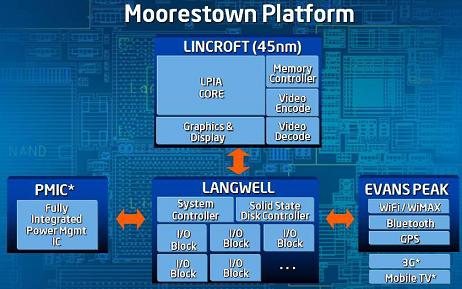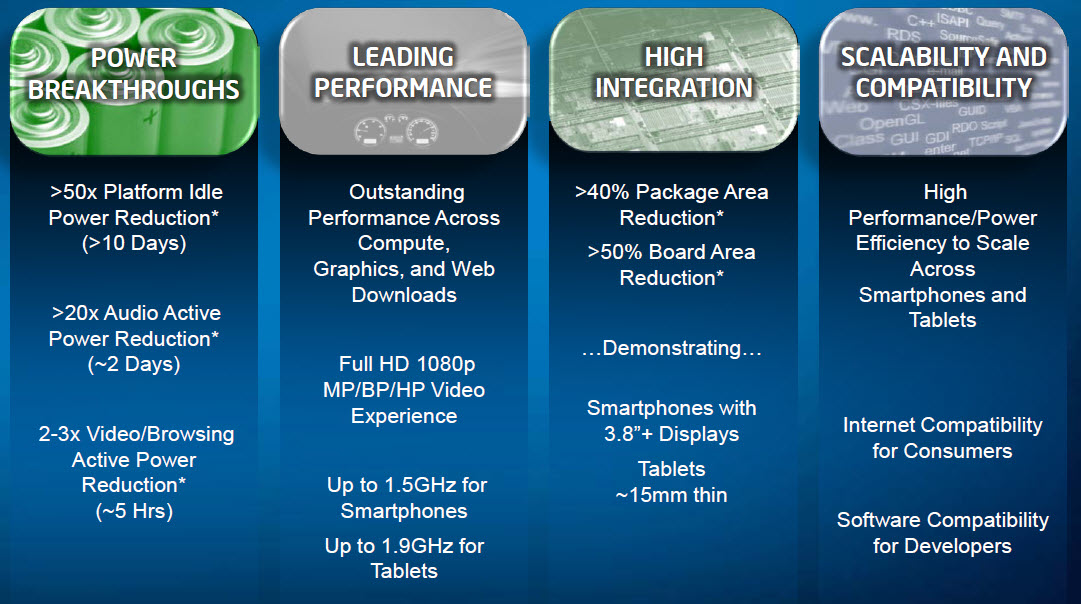Meet Moorestown: Intel's Atom Platform For The Next 10 Billion Devices
Intel’s second-gen Atom platform, Moorestown, positions the chip giant to have a killer smartphone and MID platform in 2010. The old Atom Z5xx drawbacks seem fixed. Why does Moorestown rock, and will it be enough to let Intel advance in this market?
The Moorestown Breakdown
Let’s get down to business. Moorestown is a mobility platform comprised of three key components:
Lincroft: Now known as the Atom Processor Z6xx, this is a 45 nm SoC part integrating a processor core, memory and display controllers, graphics engine, and a video engine. Why go 45 nm when the Core family is already transitioning to 32 nm and the object of the game is to be smaller? Because Moorestown was already in development when the 32 nm process change came online. In short, Intel’s time to market was faster with 45 nm, and the company could still achieve its goals on the larger node.
Langwell: This is the Intel Platform Controller Hub MP20, manufactured on a 65 nm process. Now that most of the yesteryear’s headlining chipset features have migrated to the CPU, most of what’s left in the PCH is I/O-related, although there are still a few surprises lying in wait.
Briertown: This is a dedicated Mixed Signal IC (MSIC) designed to manage power across the entire motherboard. You’ll also see the part referred to as a Power Management IC, or PMIC. Briertown is critical to Moorestown’s power-saving capabilities, but it’s actually manufactured by third-party vendors, including Freescale, Maxim, and NEC.
The fourth component that should probably be lumped in with the Moorestown platform is wireless connectivity, but this part remains too variable to be easily defined. As with Briertown, Intel has worked with numerous providers on several components that dovetail with Moorestown’s needs. Out of the gate, expect 3G products such as the M340 data/voice chip from ST-Ericsson, along with the Marvell 8688 for 802.11a/b/g Wi-Fi and Infineon’s Hammerhead 2 for GPS. More exciting will be Intel’s Wireless Multiconnection 3200, code-named Evans Peak, which will offer the 4-in-1 bundle of WiMAX, 802.11a/g/n, Bluetooth, and GPS on a single adapter.
We’ll dig into each of these pieces in the following pages. As we move through the group, keep in mind that Intel had four objectives for Moorestown, best summarized by this foil:
Among all of the points Intel wants to make with this launch, one stands far above the others: Atom’s power problems are over in the ultramobile segment. With an audio playback runtime of roughly two days and standby time exceeding 10 days, Intel can now play with the other phone chip big boys, especially ARM. Beyond that, Intel devices will be smaller than before, excel in compatibility, and deliver performance (particularly on media) that blows every other option on today’s market out of the water.
Get Tom's Hardware's best news and in-depth reviews, straight to your inbox.
If that sounds a bit hyperbolic at first glance, let’s examine the details.
-
yannifb Huh, i wonder how this will compete with Bobcat, which supposedly will have 90% of desktop chip performance according to AMD.Reply -
descendency Why isn't this a 32nm product yet? If your concern (which it would be with said devices) is power consumption, shrinking the die can only help...Reply -
Greg_77 silverx75Man, and the HTC Incredible just came out....Man, and I just got the HTC Incredible... ;)Reply
And so the march of technology continues! -
well we can only wait till amd gets their ULV chips out with their on die graphics so we can get a nice comparison.Reply
-
williamvw descendencyWhy isn't this a 32nm product yet? If your concern (which it would be with said devices) is power consumption, shrinking the die can only help...Time to market. 45 nm was quicker for development and it accomplished what needed to get done at this time. That's the official answer. Unofficially, sure, we all know 32 nm will help, but this is business for consumers. Right or wrong, you don't play all of your cards right away.Reply
-
seboj I've only had time to read half the article so far, but I'm excited! Good stuff, good stuff.Reply -
burnley14 This is more exciting to me than the release of 6-core processors and the like because these advances produce tangible results for my daily use. Good work Intel!Reply -
ta152h Do we really need x86 plaguing phones now? Good God, why didn't they use a more efficient instruction set for this? Compatibility isn't very important with the PC, since all the software will be new anyway.Reply
I like the Atom, but not in this role. x86 adds inefficiencies that aren't balanced by a need for compatibility in this market.

